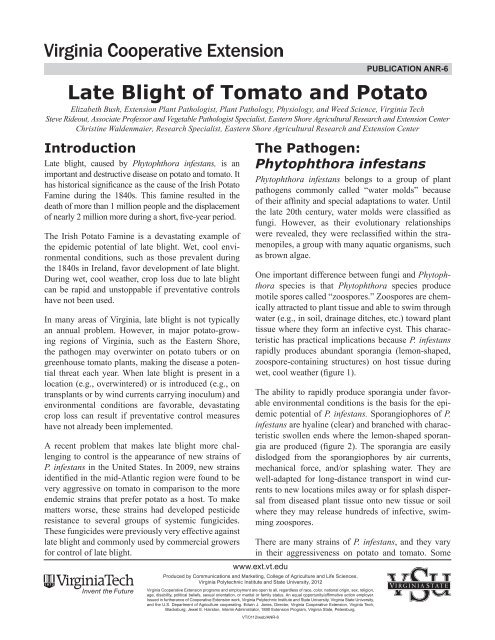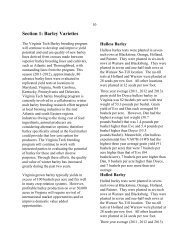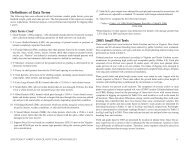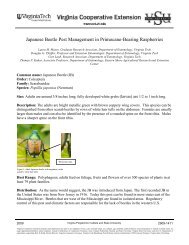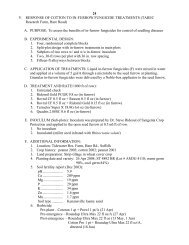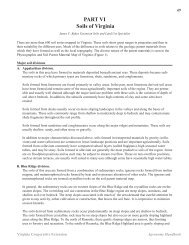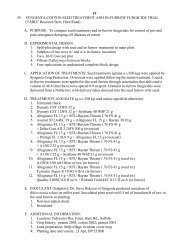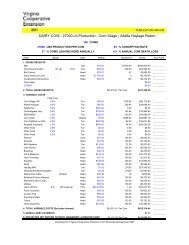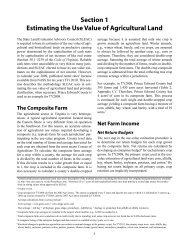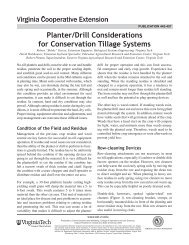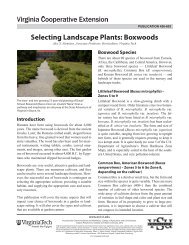Late Blight of Tomato and Potato - Virginia Cooperative Extension ...
Late Blight of Tomato and Potato - Virginia Cooperative Extension ...
Late Blight of Tomato and Potato - Virginia Cooperative Extension ...
Create successful ePaper yourself
Turn your PDF publications into a flip-book with our unique Google optimized e-Paper software.
Introduction<br />
<strong>Late</strong> blight, caused by Phytophthora infestans, is an<br />
important <strong>and</strong> destructive disease on potato <strong>and</strong> tomato. It<br />
has historical significance as the cause <strong>of</strong> the Irish <strong>Potato</strong><br />
Famine during the 1840s. This famine resulted in the<br />
death <strong>of</strong> more than 1 million people <strong>and</strong> the displacement<br />
<strong>of</strong> nearly 2 million more during a short, five-year period.<br />
The Irish <strong>Potato</strong> Famine is a devastating example <strong>of</strong><br />
the epidemic potential <strong>of</strong> late blight. Wet, cool environmental<br />
conditions, such as those prevalent during<br />
the 1840s in Irel<strong>and</strong>, favor development <strong>of</strong> late blight.<br />
During wet, cool weather, crop loss due to late blight<br />
can be rapid <strong>and</strong> unstoppable if preventative controls<br />
have not been used.<br />
In many areas <strong>of</strong> <strong>Virginia</strong>, late blight is not typically<br />
an annual problem. However, in major potato-growing<br />
regions <strong>of</strong> <strong>Virginia</strong>, such as the Eastern Shore,<br />
the pathogen may overwinter on potato tubers or on<br />
greenhouse tomato plants, making the disease a potential<br />
threat each year. When late blight is present in a<br />
location (e.g., overwintered) or is introduced (e.g., on<br />
transplants or by wind currents carrying inoculum) <strong>and</strong><br />
environmental conditions are favorable, devastating<br />
crop loss can result if preventative control measures<br />
have not already been implemented.<br />
A recent problem that makes late blight more challenging<br />
to control is the appearance <strong>of</strong> new strains <strong>of</strong><br />
P. infestans in the United States. In 2009, new strains<br />
identified in the mid-Atlantic region were found to be<br />
very aggressive on tomato in comparison to the more<br />
endemic strains that prefer potato as a host. To make<br />
matters worse, these strains had developed pesticide<br />
resistance to several groups <strong>of</strong> systemic fungicides.<br />
These fungicides were previously very effective against<br />
late blight <strong>and</strong> commonly used by commercial growers<br />
for control <strong>of</strong> late blight.<br />
www.ext.vt.edu<br />
Produced by Communications <strong>and</strong> Marketing, College <strong>of</strong> Agriculture <strong>and</strong> Life Sciences,<br />
<strong>Virginia</strong> Polytechnic Institute <strong>and</strong> State University, 2012<br />
<strong>Virginia</strong> <strong>Cooperative</strong> <strong>Extension</strong> programs <strong>and</strong> employment are open to all, regardless <strong>of</strong> race, color, national origin, sex, religion,<br />
age, disability, political beliefs, sexual orientation, or marital or family status. An equal opportunity/affirmative action employer.<br />
Issued in furtherance <strong>of</strong> <strong>Cooperative</strong> <strong>Extension</strong> work, <strong>Virginia</strong> Polytechnic Institute <strong>and</strong> State University, <strong>Virginia</strong> State University,<br />
<strong>and</strong> the U.S. Department <strong>of</strong> Agriculture cooperating. Edwin J. Jones, Director, <strong>Virginia</strong> <strong>Cooperative</strong> <strong>Extension</strong>, <strong>Virginia</strong> Tech,<br />
Blacksburg; Jewel E. Hairston, Interim Administrator, 1890 <strong>Extension</strong> Program, <strong>Virginia</strong> State, Petersburg.<br />
1<br />
VT/0112/web/ANR-6<br />
PUBLICATION ANR-6<br />
<strong>Late</strong> <strong>Blight</strong> <strong>of</strong> <strong>Tomato</strong> <strong>and</strong> <strong>Potato</strong><br />
Elizabeth Bush, <strong>Extension</strong> Plant Pathologist, Plant Pathology, Physiology, <strong>and</strong> Weed Science, <strong>Virginia</strong> Tech<br />
Steve Rideout, Associate Pr<strong>of</strong>essor <strong>and</strong> Vegetable Pathologist Specialist, Eastern Shore Agricultural Research <strong>and</strong> <strong>Extension</strong> Center<br />
Christine Waldenmaier, Research Specialist, Eastern Shore Agricultural Research <strong>and</strong> <strong>Extension</strong> Center<br />
The Pathogen:<br />
Phytophthora infestans<br />
Phytophthora infestans belongs to a group <strong>of</strong> plant<br />
pathogens commonly called “water molds” because<br />
<strong>of</strong> their affinity <strong>and</strong> special adaptations to water. Until<br />
the late 20th century, water molds were classified as<br />
fungi. However, as their evolutionary relationships<br />
were revealed, they were reclassified within the stramenopiles,<br />
a group with many aquatic organisms, such<br />
as brown algae.<br />
One important difference between fungi <strong>and</strong> Phytophthora<br />
species is that Phytophthora species produce<br />
motile spores called “zoospores.” Zoospores are chemically<br />
attracted to plant tissue <strong>and</strong> able to swim through<br />
water (e.g., in soil, drainage ditches, etc.) toward plant<br />
tissue where they form an infective cyst. This characteristic<br />
has practical implications because P. infestans<br />
rapidly produces abundant sporangia (lemon-shaped,<br />
zoospore-containing structures) on host tissue during<br />
wet, cool weather (figure 1).<br />
The ability to rapidly produce sporangia under favorable<br />
environmental conditions is the basis for the epidemic<br />
potential <strong>of</strong> P. infestans. Sporangiophores <strong>of</strong> P.<br />
infestans are hyaline (clear) <strong>and</strong> branched with characteristic<br />
swollen ends where the lemon-shaped sporangia<br />
are produced (figure 2). The sporangia are easily<br />
dislodged from the sporangiophores by air currents,<br />
mechanical force, <strong>and</strong>/or splashing water. They are<br />
well-adapted for long-distance transport in wind currents<br />
to new locations miles away or for splash dispersal<br />
from diseased plant tissue onto new tissue or soil<br />
where they may release hundreds <strong>of</strong> infective, swimming<br />
zoospores.<br />
There are many strains <strong>of</strong> P. infestans, <strong>and</strong> they vary<br />
in their aggressiveness on potato <strong>and</strong> tomato. Some
isolates from potato are not too aggressive on tomato,<br />
but some can be aggressive on both tomato <strong>and</strong> potato,<br />
such as the new strains isolated in the United States in<br />
2009.<br />
Symptoms on <strong>Tomato</strong><br />
<strong>Late</strong> blight affects all aboveground parts <strong>of</strong> the tomato<br />
plant. The first symptoms usually appear on leaves<br />
as water-soaked, oily, pale or dark-green or brown/<br />
black, circular or irregular lesions (figure 3). Typically,<br />
younger, more succulent, tissue is affected first (figure<br />
4). During periods <strong>of</strong> abundant moisture, sporulation <strong>of</strong><br />
the pathogen can be seen by the naked eye as a white,<br />
cottony growth on the underside <strong>of</strong> affected leaves <strong>and</strong>/<br />
or on fruit lesions (figure 5).<br />
Figure 1. One lemon-shaped sporangium (zoosporecontaining<br />
structure) <strong>of</strong> Phytophthora infestans on<br />
a sporangiophore <strong>and</strong> two sporangia that have been<br />
dislodged.<br />
Photo by E. Bush<br />
Figure 3. A tomato leaf with the first symptoms <strong>of</strong> late<br />
blight; these typically appear on the leaves as watersoaked,<br />
oily, pale or dark green or brown/black, circular or<br />
irregular lesions.<br />
Photo by E. Bush.<br />
Figure 2. Sporangiophores <strong>of</strong> Phytophthora infestans from<br />
which all sporangia have been dislodged on tomato leaf<br />
tissue. Note the characteristic swellings on the ends <strong>of</strong> the<br />
sporangiophores.<br />
Photo by E. Bush.<br />
Figure 4. Young, succulent leaf tissue is typically first<br />
affected by the late blight pathogen.<br />
Photo courtesy <strong>of</strong> Harold Jerrell.<br />
2
Figure 5. White, cottony sporulation <strong>of</strong> the late blight<br />
pathogen on a tomato.<br />
Photo by E. Bush.<br />
Figure 7. Oily, brown/copper-colored, sunken lesions <strong>of</strong> late<br />
blight on green tomato.<br />
Photo courtesy <strong>of</strong> Harold Jerrell.<br />
When wet <strong>and</strong> cool conditions are prevalent, the disease<br />
usually progresses rapidly through the plant canopy<br />
<strong>and</strong> crop, resulting in brown, shriveled foliage<br />
(figure 6). Both green <strong>and</strong> ripe tomatoes are susceptible<br />
to severe injury from late blight. Oily, brown/copper in<br />
color, <strong>and</strong> <strong>of</strong>ten-sunken lesions form on both green <strong>and</strong><br />
ripe fruits, which may remain firm (figure 7). Lesions<br />
may spread over the surface <strong>of</strong> the tomato, <strong>and</strong> secondary<br />
decay organisms generally follow the late blight<br />
infection, causing various fruit rots (figure 8).<br />
Often, the stem end <strong>of</strong> the fruit is affected first (figure 9),<br />
because spores tend to l<strong>and</strong> on the top <strong>of</strong> fruit <strong>and</strong> small<br />
cracks favor infection by the pathogen; however, this<br />
is not always the case. Petioles <strong>and</strong> stems also develop<br />
dark, oily lesions (figure 10). The odor from rotting, lateblight-diseased<br />
plants <strong>and</strong> fruits is characteristically foul.<br />
Figure 8. <strong>Late</strong> blight lesions on tomatoes that have been<br />
further colonized by secondary decay organisms, which<br />
cause additional fruit rot.<br />
Photo courtesy <strong>of</strong> Harold Jerrell.<br />
Figure 6. Under cool, moist conditions, late blight<br />
progressed rapidly through this tomato crop, leaving brown<br />
<strong>and</strong> withered foliage.<br />
Photo courtesy <strong>of</strong> Harold Jerrell.<br />
Figure 9. Often the stem end <strong>of</strong> fruit is first affected, because<br />
spores tend to l<strong>and</strong> on the top <strong>of</strong> the fruit <strong>and</strong> small cracks<br />
favor infection by Phytophthora infestans. Photo by E. Bush.<br />
3
Figure 12. Brownish, irregular lesions on potato with late<br />
blight. Photo courtesy <strong>of</strong> R. W. Samson, Purdue University, Bugwood.org.<br />
Figure 10. Dark, oily lesions <strong>of</strong> Phytophthora infestans on<br />
the stems <strong>of</strong> a tomato plant.<br />
Photo by E. Bush.<br />
Symptoms on <strong>Potato</strong><br />
Leaf, petiole, <strong>and</strong> stem symptoms on potato are similar<br />
to those described above for tomato (figure 11). On<br />
tubers, copper/brown, irregular lesions form <strong>and</strong> cause<br />
a dry, firm rot (figure 12). Beneath the skin, the flesh is<br />
discolored <strong>and</strong> grainy (figure 13). Tuber rot may extend<br />
about 1 inch or less into the tuber when soil conditions<br />
are dry, but in wet soil conditions, tuber decay progresses<br />
rapidly <strong>and</strong> tubers may rot completely.<br />
If infected tubers are placed in cool, dry storage, disease<br />
progression slows or stops <strong>and</strong> lesions become dry. However,<br />
the disease is not eliminated, <strong>and</strong> P. infestans can<br />
resume growth <strong>and</strong> sporulation when environmental conditions<br />
become favorable again. Diseased tubers are prone<br />
to invasion by secondary decay organisms that can cause<br />
various tuber rots. As with tomato, when wet <strong>and</strong> cool<br />
conditions are prevalent, the disease typically progresses<br />
rapidly through the plant canopy <strong>and</strong> crop (figure 14). 1<br />
Figure 13. Discolored, grainy flesh <strong>of</strong><br />
potato with late blight.<br />
Photo courtesy <strong>of</strong> Scott Bauer, USDA<br />
Agricultural Research Service, Bugwood.org.<br />
Figure 14. A commercial potato field in the Eastern Shore<br />
<strong>of</strong> <strong>Virginia</strong> that experienced progressive devastation from<br />
the late blight pathogen.<br />
Photo by C.Waldenmaier.<br />
Figure 11. <strong>Blight</strong>ed leaves, petiole, <strong>and</strong> stem lesions on<br />
potato.<br />
Photo by C. Waldenmaier.<br />
1<br />
Additional images <strong>of</strong> late blight on tomato <strong>and</strong> potato can be found<br />
at the <strong>Virginia</strong> Tech Eastern Shore Agricultural Research <strong>and</strong> <strong>Extension</strong><br />
Center’s Facebook page (www.facebook.com/vtesarecpp) <strong>and</strong><br />
at the Plant Disease Clinic’s plant problem image gallery (http://<br />
ppwsidlab.contentsrvr.net/plant.vesh).<br />
4
Disease Cycle<br />
Hosts <strong>of</strong> P. infestans are limited to members <strong>of</strong> the<br />
nightshade family (tomato, potato, pepper, eggplant,<br />
petunia, <strong>and</strong> some weedy members <strong>of</strong> the family, such<br />
as hairy nightshade). P. infestans is an obligate pathogen;<br />
therefore, it cannot live in the absence <strong>of</strong> living<br />
host tissue. Unlike many pathogens, P. infestans cannot<br />
overwinter on dead plant tissue, on stakes, or in soil. 2 It<br />
is also not seedborne. However, P. infestans can survive<br />
in infected potato tubers, <strong>and</strong> volunteer plants growing<br />
from infected tubers during the following growing<br />
season can serve as a source <strong>of</strong> inoculum for new outbreaks<br />
<strong>of</strong> late blight. Zoospores <strong>of</strong> P. infestans can also<br />
be carried in wind currents for long distances to initiate<br />
disease outbreaks in new geographic areas; late blight<br />
is commonly spread to new locations by this means.<br />
Other potential sources <strong>of</strong> P. infestans inoculum are<br />
late-blight-infected tomato transplants that are shipped<br />
to northern locations from southern areas where freezes<br />
do not occur <strong>and</strong> diseased plants that are overwintered<br />
in greenhouses. The former situation occurred in 2009<br />
when late-blight-diseased tomato transplants were<br />
shipped from transplant growing operations to retail<br />
outlets. This man-made movement <strong>of</strong> late blight inoculum<br />
to northern locations so early in the season, along<br />
with favorable environmental conditions for late blight<br />
development, contributed to a serious outbreak <strong>of</strong> late<br />
blight that was unusual in terms <strong>of</strong> the widespread<br />
extent <strong>of</strong> the disease in the Northeast, Southeast, <strong>and</strong><br />
Midwest relatively early in the season.<br />
Production <strong>of</strong> zoospores <strong>and</strong> infection by P. infestans are<br />
rapid when daytime temperatures are between 70 <strong>and</strong> 80<br />
degrees Fahrenheit, nighttime temperatures are between<br />
50 F <strong>and</strong> 60 F, <strong>and</strong> rainfall or abundant moisture is present.<br />
Moisture is necessary for sporulation <strong>and</strong> infection.<br />
When temperatures rise above 86 F, P. infestans’ ability<br />
to sporulate <strong>and</strong> infect new tissue is hampered. Therefore,<br />
new late blight infections do not occur during hot<br />
weather, <strong>and</strong> the disease does not spread rapidly.<br />
Infested potato foliage that drops to the soil leads to<br />
tuber infection. Zoospores produced on the foliage<br />
move through water to tubers where they infect <strong>and</strong><br />
colonize tubers. Soil temperatures below 65 F are necessary<br />
for potato tuber infection to occur.<br />
Preventative Tactics to<br />
Avoid <strong>Late</strong> <strong>Blight</strong><br />
Tactics to prevent late blight, including cultural controls<br />
<strong>and</strong> fungicide applications, should be implemented<br />
before the disease is present in the garden or field (refer<br />
to the bulleted list <strong>of</strong> tactics in the box below). This is<br />
because under favorable environmental conditions (cool<br />
<strong>and</strong> moist) the late blight pathogen spreads extremely<br />
rapidly through the crop, producing abundant amounts<br />
<strong>of</strong> inoculum that initiate new infections. A grower who<br />
waits until the disease is present in a crop to begin control<br />
tactics generally will be fighting a losing battle if environmental<br />
conditions are favorable for disease.<br />
Preventative tactics for late blight should be<br />
implemented before the disease is present in<br />
the garden or field. Both cultural controls <strong>and</strong><br />
preventative fungicide sprays are necessary to<br />
manage late blight. Preventative tactics include:<br />
• Purchase disease-free transplants <strong>and</strong> seed<br />
tubers.<br />
• Bury, dispose <strong>of</strong>, or properly compost potato culls<br />
rather than forming cull piles.<br />
• Remove volunteer potato plants.<br />
• Remove <strong>and</strong> dispose <strong>of</strong> late-blight-diseased<br />
plants in garden settings.<br />
• Reduce periods <strong>of</strong> leaf wetness by spacing<br />
plants adequately, limiting the size <strong>of</strong> the plant<br />
canopy, avoiding overhead irrigation <strong>and</strong> morning<br />
irrigation, staking plants, <strong>and</strong> locating plants in<br />
areas with good air movement.<br />
• Avoid excessive use <strong>of</strong> nitrogen fertilizer.<br />
• Consider using cultivars with resistance to late<br />
blight.<br />
• Apply pesticides before the disease is in your<br />
garden or field when conditions are moist <strong>and</strong><br />
cool <strong>and</strong> late blight is a threat in your area (e.g.,<br />
late blight has been identified in nearby regions).<br />
• Apply pesticides so thorough coverage <strong>of</strong> plant<br />
tissue is achieved.<br />
• Commercial growers: Use disease-forecastingsystem<br />
information to manage late blight.<br />
• Noncommercial growers: Use your local<br />
<strong>Virginia</strong> <strong>Cooperative</strong> <strong>Extension</strong> (VCE) <strong>of</strong>fice to<br />
monitor likelihood <strong>of</strong> late blight in your area.<br />
2<br />
Currently known populations <strong>of</strong> P. infestans in the U.S. are clonal lineages. This is an indication that P. infestans is not sexually reproducing<br />
<strong>and</strong> spread <strong>of</strong> the pathogen is occurring only through production <strong>of</strong> sporangia, which occurs asexually. To sexually reproduce, P. infestans<br />
requires the presence <strong>of</strong> A1 <strong>and</strong> A2 mating types in a location. Both A1 <strong>and</strong> A2 mating types have been found in locations in the U.S.; however,<br />
there is currently no indication that sexual reproduction has occurred. This is <strong>of</strong> practical significance, because sexual reproduction by<br />
P. infestans results in a thick-walled sexual structure (oospore) capable <strong>of</strong> survival for long periods <strong>of</strong> time in soil. In other areas <strong>of</strong> the world,<br />
P. infestans does sexually reproduce <strong>and</strong> may overwinter in the soil.<br />
5
Cultural Controls<br />
There are a number <strong>of</strong> cultural controls that can be<br />
implemented to minimize infection <strong>and</strong> spread <strong>of</strong> late<br />
blight. Cultural control tactics <strong>and</strong> preventative fungicide<br />
sprays should be used together in an integrated<br />
pest management program for the best chance <strong>of</strong> controlling<br />
this disease.<br />
Purchase Disease-Free Transplants<br />
<strong>and</strong> <strong>Potato</strong> Seed Tubers<br />
After diseased tomato transplants were shipped<br />
throughout the Northeast in 2009, the tomato transplant-growing<br />
industry implemented practices to avoid<br />
this situation in the future. However, it is still advisable<br />
to carefully examine any tomato transplants for symptoms<br />
<strong>of</strong> disease before purchasing. Purchase certified<br />
seed tubers from reliable sources <strong>and</strong> examine them<br />
carefully upon arrival <strong>and</strong> before planting.<br />
Sanitation<br />
It is advisable to bury, dispose <strong>of</strong>, or properly compost<br />
potato culls rather than forming cull piles. Piles<br />
<strong>of</strong> culled tubers may not freeze entirely, <strong>and</strong> P. infestans<br />
can overwinter on tissue that is not completely<br />
killed. Remove volunteer potato plants as soon as they<br />
appear or kill them with herbicide. Removing lateblight-diseased<br />
plants to prevent spread to other plants<br />
is not likely to be effective, because this disease spreads<br />
so rapidly <strong>and</strong> produces so much airborne inoculum.<br />
Nevertheless, removal <strong>of</strong> late-blight-diseased plants is<br />
recommended in garden settings to reduce inoculum<br />
available for new infections. Options for disposing <strong>of</strong><br />
diseased plants include tilling or burying plants, placing<br />
plants in plastic bags, <strong>and</strong> covering plants with a<br />
tarp until the tissue is completely killed.<br />
Environmental<br />
Any cultural practice that reduces leaf wetness (e.g.,<br />
spacing plants adequately, limiting the size <strong>of</strong> the<br />
plant canopy, avoiding overhead irrigation, irrigating<br />
in the morning to promote foliar drying, staking<br />
plants, planting in locations with good air movement)<br />
is recommended. Avoid excessive use <strong>of</strong> nitrogen fertilizer,<br />
which promotes succulent tissue that is more<br />
prone to infection, <strong>and</strong> large foliar canopies that favor<br />
leaf wetness <strong>and</strong> make thorough pesticide coverage<br />
unlikely.<br />
Resistance<br />
<strong>Tomato</strong> <strong>and</strong> potato cultivars with varying resistance to<br />
some races <strong>of</strong> P. infestans have been developed, <strong>and</strong><br />
breeding for resistance in tomato <strong>and</strong> potato is ongoing.<br />
Cultivars resistant to all races <strong>of</strong> the pathogen are not<br />
currently available, so late-blight-resistant plants are<br />
not reliable in all cases. In general, heirloom cultivars<br />
<strong>of</strong> tomato are more susceptible to late blight infections<br />
than more recently released cultivars. Growers should<br />
keep informed <strong>of</strong> the current availability <strong>of</strong> late-blightresistant<br />
cultivars.<br />
Disease Forecasting<br />
Home gardeners are advised to check with their local<br />
<strong>Virginia</strong> <strong>Cooperative</strong> <strong>Extension</strong> agent (www.ext.vt.edu/<br />
<strong>of</strong>fices/) when environmental conditions favorable to<br />
late blight (i.e., cool <strong>and</strong> moist) are prevalent to determine<br />
if preventative fungicide treatments are advisable<br />
(e.g., if late blight has been identified in nearby<br />
regions).<br />
Commercial producers should use information from<br />
disease-forecasting systems, such as BLITECAST or<br />
WISDOM, to determine when late blight is a threat in<br />
their areas <strong>and</strong> fungicide treatments are advisable. The<br />
use <strong>of</strong> disease-forecast systems reduces the amount<br />
<strong>of</strong> fungicide sprays needed to effectively manage late<br />
blight. The <strong>Virginia</strong> AG Pest Advisory (www.sripmc.<br />
org/<strong>Virginia</strong>) sends electronic pest alerts <strong>and</strong> recommendations<br />
about fungicide applications to commercial<br />
producers, crop consultants, <strong>and</strong> <strong>Extension</strong> agents. To<br />
sign up for alerts from the <strong>Virginia</strong> AG Pest Advisory,<br />
contact your local <strong>Extension</strong> agent.<br />
Pesticide Control<br />
Recommendations for Home<br />
Gardeners<br />
Home gardeners must rely on repeated applications <strong>of</strong><br />
preventative fungicides to avoid late blight problems.<br />
Spread <strong>of</strong> late blight is so rapid under favorable environmental<br />
conditions that fungicides must be applied<br />
before the disease is observed in order to be effective.<br />
If the weather in your location is predominantly hot<br />
(above 86 F) <strong>and</strong> dry, preventative sprays would not be<br />
recommended. If weather conditions are predominantly<br />
cool <strong>and</strong> moist, your local <strong>Virginia</strong> <strong>Cooperative</strong> <strong>Extension</strong><br />
agent (www.ext.vt.edu/<strong>of</strong>fices/) can assist you in<br />
determining if preventative pesticide applications may be<br />
6
advisable. This will depend on whether or not late blight<br />
has been identified in nearby locations. VCE specialists<br />
<strong>and</strong> agents monitor weather conditions <strong>and</strong> regional late<br />
blight activity to determine if preventative applications<br />
<strong>of</strong> fungicides are recommended in <strong>Virginia</strong> counties.<br />
If a fungicide application is needed, thorough coverage<br />
<strong>of</strong> plant foliage is essential for effective late blight<br />
control, <strong>and</strong> repeated applications will be necessary (follow<br />
product label directions <strong>and</strong> rates). For information<br />
on pesticides labeled for management <strong>of</strong> late blight on<br />
tomato <strong>and</strong> potato, refer to VCE publication 456-018,<br />
the current VCE Pest Management Guide, available<br />
online at http://pubs.ext.vt.edu/456/456-018/456-018.<br />
html or your local <strong>Virginia</strong> <strong>Cooperative</strong> <strong>Extension</strong> <strong>of</strong>fice<br />
(www.ext.vt.edu/<strong>of</strong>fices/).<br />
Pesticide Control<br />
Recommendations for<br />
Commercial Growers<br />
Conventional Production<br />
For up-to-date fungicide recommendations, refer to the<br />
current VCE publication 456-420, “Commercial Vegetable<br />
Production Recommendations” (http://pubs.ext.<br />
vt.edu/456/456-420/456-420.html) or your local <strong>Virginia</strong><br />
<strong>Cooperative</strong> <strong>Extension</strong> <strong>of</strong>fice (www.ext.vt.edu/<br />
<strong>of</strong>fices/).<br />
Pesticide Resistance Considerations<br />
for Conventional Producers<br />
Systemic phenylamide fungicides, such as mefenoxam<br />
or metalaxyl, were first available for control <strong>of</strong> late<br />
blight in the late 1970s. Prior to their introduction, late<br />
blight control depended on repeated applications <strong>of</strong><br />
broad-spectrum, preventative fungicides. Phenylamide<br />
fungicides were very effective at late blight control, but<br />
they were also at very high risk for development <strong>of</strong> pesticide<br />
resistance in the pathogen populations.<br />
Unfortunately, pesticide resistance by P. infestans to<br />
products containing mefenoxam/metalaxyl occurred<br />
rapidly in locations where these fungicides were not<br />
tank-mixed with broad-spectrum, preventative pesticides.<br />
Growers are strongly advised to strictly follow<br />
practices that will avoid development <strong>of</strong> pesticideresistant<br />
P. infestans populations when using products<br />
that contain mefenoxam/metalaxyl or any other chemistry<br />
at risk <strong>of</strong> pesticide resistance development (see the<br />
following box for suggestions).<br />
Avoiding development <strong>of</strong> pesticide resistance<br />
when using at-risk pesticide products:<br />
• Use at-risk products only as protectants, not as<br />
eradicants.<br />
• Apply at-risk products in a mixture with a broadspectrum<br />
protectant product, following label<br />
rates.<br />
• Apply foliar applications to control foliar<br />
outbreaks.<br />
• Limit sprays <strong>of</strong> an at-risk product to two to four<br />
consecutive applications in a crop annually,<br />
with applications no more than 14 days apart.<br />
Overuse <strong>of</strong> these products favors development <strong>of</strong><br />
pesticide-resistant strains <strong>of</strong> the pathogen.<br />
• Refer to the product label for further fungicideresistant,<br />
risk management information.<br />
Commercial Organic <strong>Potato</strong> <strong>and</strong><br />
<strong>Tomato</strong> Production<br />
Organic potato <strong>and</strong> tomato producers must rely on<br />
Organic Materials Review Institute-listed products<br />
(www.omri.org/) labeled for control <strong>of</strong> late blight on<br />
tomato/potato, such as copper <strong>and</strong> sulfur products <strong>and</strong><br />
selected biological fungicides. These products must be<br />
applied preventatively, <strong>and</strong> repeated applications will<br />
be necessary when environmental conditions are favorable.<br />
Thorough coverage <strong>of</strong> foliage is essential. Follow<br />
product label directions <strong>and</strong> precautions. There are a<br />
number <strong>of</strong> publications <strong>and</strong> webinars on organic management<br />
<strong>of</strong> late blight at the eXtension website (www.<br />
extension.org/).<br />
Greenhouse Production<br />
Greenhouse growers should be aware that petunia<br />
(Petunia x hybrida) is susceptible to late blight. While<br />
late blight on petunia has been reported infrequently,<br />
there have been outbreaks <strong>of</strong> late blight on petunia that<br />
have been linked to epidemics <strong>of</strong> the disease on tomato.<br />
Additionally, the disease on petunia has been reported<br />
to have been introduced to greenhouses on petunia<br />
transplants <strong>and</strong> bedding plant producers <strong>of</strong>ten grow<br />
petunia <strong>and</strong> tomato in the same greenhouse. It is advisable<br />
to separate petunia <strong>and</strong> tomato crops when possible<br />
<strong>and</strong> carefully monitor any transplants introduced<br />
to the greenhouse for symptoms <strong>of</strong> late blight. Because<br />
<strong>of</strong> the epidemic potential <strong>of</strong> late blight, there is a serious<br />
concern that late blight inoculum produced in the<br />
greenhouse may serve as primary inoculum to nearby<br />
tomato <strong>and</strong> potato fields.<br />
7
Any practice that reduces the period <strong>of</strong> leaf wetness<br />
will deter development <strong>of</strong> late blight, so growers should<br />
ensure adequate air flow <strong>and</strong> promote low relative<br />
humidity in the greenhouse. Growers should also avoid<br />
overhead irrigation <strong>of</strong> petunia <strong>and</strong> tomato, because this<br />
causes long periods <strong>of</strong> leaf wetness. Growers should<br />
scout susceptible crops during cool, wet weather <strong>and</strong><br />
when late blight has been reported in the area. New<br />
susceptible transplants should be monitored closely for<br />
symptom development. Once late blight is present in a<br />
greenhouse, all affected plant tissue should be removed<br />
<strong>and</strong> destroyed properly.<br />
A limited number <strong>of</strong> fungicides are labeled for use in<br />
the greenhouse. Refer to the product label for application<br />
instructions <strong>and</strong>, because product labels frequently<br />
change, refer to a pesticide database, such as Crop Data<br />
Management Systems Inc. (www.cdms.net) or the product<br />
manufacturer’s website for updated labels.<br />
If late blight has been identified in the greenhouse, a<br />
fallow period is recommended. During this time, all<br />
infested crop debris should be removed <strong>and</strong> properly<br />
disposed <strong>of</strong>, which will be sufficient for disinfesting,<br />
because the late blight pathogen can only be harbored<br />
on susceptible, living, host tissue.<br />
Acknowledgements<br />
This publication benefited from the critical review <strong>of</strong> Andy<br />
Wyen<strong>and</strong>t, <strong>Extension</strong> specialist, Rutgers University; Josh<br />
Freeman, assistant pr<strong>of</strong>essor, Eastern Shore Agricultural<br />
Research <strong>and</strong> <strong>Extension</strong> Center; <strong>and</strong> Scott Jerrell <strong>and</strong> Jon<br />
Vest, <strong>Virginia</strong> <strong>Cooperative</strong> <strong>Extension</strong> agents.<br />
References<br />
Becktell, M. C., M. L. Daughtrey, <strong>and</strong> W. E. Fry. 2005.<br />
Epidemiology <strong>and</strong> management <strong>of</strong> petunia <strong>and</strong><br />
tomato late blight in the greenhouse. Plant Disease<br />
89:1,000–08.<br />
Brent, K. J., <strong>and</strong> D. W. Hollomon. 2007. Fungicide<br />
Resistance in Crop Plants: How Can It Be<br />
Managed?, 2nd revised ed. Brussels: Fungicide<br />
Resistance Action Committee. Available at<br />
www.frac.info/frac/publication/anhang/FRAC_<br />
Mono1_2007_100dpi.pdf.<br />
Fungicide Resistance Action Committee. 2011. FRAC<br />
Code List: Fungicides Sorted by Mode <strong>of</strong> Action<br />
(Including FRAC Code Numbering). Brussels:<br />
Fungicide Resistance Action Committee. Available<br />
at www.frac.info/frac/index.htm.<br />
Howard, R. J., J. A. Garl<strong>and</strong>, <strong>and</strong> W. L. Seaman, eds.<br />
1994. Diseases <strong>and</strong> Pests <strong>of</strong> Vegetable Crops in<br />
Canada. Ottawa, Ontario: Canadian Phytopathological<br />
Society <strong>and</strong> Entomological Society <strong>of</strong><br />
Canada.<br />
Jones, J. P., R. E. Stall, <strong>and</strong> T. A. Zitter. 1991. Compendium<br />
<strong>of</strong> <strong>Tomato</strong> Diseases. Edited by T. A. Zitter. St.<br />
Paul, Minn.: APS Press.<br />
Kawchuk, L. M., R. J. Howard, R. D. Peters, <strong>and</strong> K.<br />
I. Al-Mughrabi. 2011. First report <strong>of</strong> Phytophthora<br />
infestans Genotype US23 causing late blight in<br />
Canada. Plant Disease 95:873.<br />
McGrath, M. T. 2010. Managing <strong>Late</strong> <strong>Blight</strong> in Organically<br />
Produced <strong>Potato</strong>. Available at http://njveg.<br />
rutgers.edu/assets/pdfs/cp/<strong>Late</strong><strong>Blight</strong>Organic<strong>Potato</strong>-MGT2010.pdf.<br />
Schumann, G. L., <strong>and</strong> C. J. D’Arcy. 2000. <strong>Late</strong> <strong>Blight</strong><br />
<strong>of</strong> <strong>Potato</strong> <strong>and</strong> <strong>Tomato</strong>. American Phytopathological<br />
Society, APSnet. Available at www.apsnet.org/<br />
edcenter/intropp/lessons/fungi/Oomycetes/Pages/<br />
<strong>Late</strong><strong>Blight</strong>.aspx.<br />
Stone, A. 2010. Organic Management <strong>of</strong> <strong>Late</strong> <strong>Blight</strong><br />
<strong>of</strong> <strong>Potato</strong> <strong>and</strong> <strong>Tomato</strong> (Phytophthora infestans).<br />
Available at www.extension.org/article/18361.<br />
8


